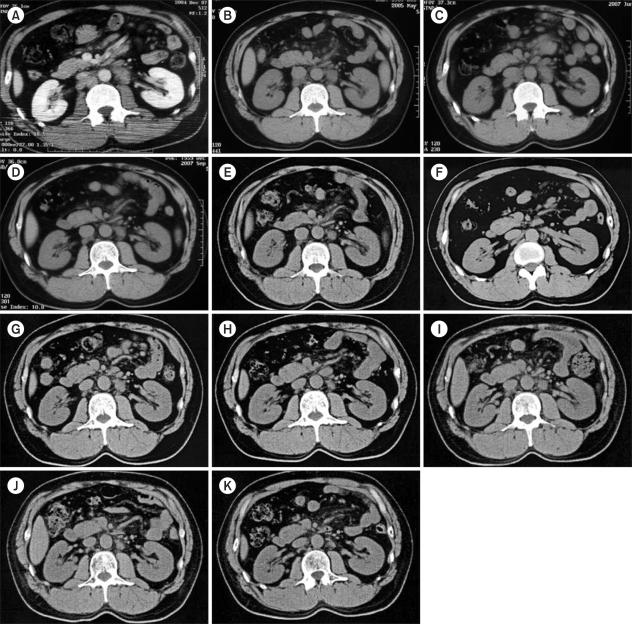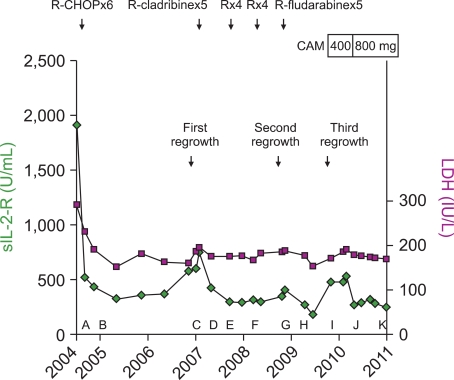Korean J Hematol.
2011 Sep;46(3):203-206. 10.5045/kjh.2011.46.3.203.
A case of follicular B-cell lymphoma treated using clarithromycin
- Affiliations
-
- 1Department of General Medicine, Hokkaido Social Insurance Hospital, Sapporo, Japan. masshi@isis.ocn.ne.jp
- 2Department of Gastroenterology and Hematology, Hokkaido University Graduate School of Medicine, Sapporo, Japan.
- KMID: 2252006
- DOI: http://doi.org/10.5045/kjh.2011.46.3.203
Abstract
- We report a case of follicular B-cell lymphoma (FL) treated successfully using clarithromycin (CAM). A 44-year-old man who presented with lymphadenopathy was diagnosed with FL after a histological examination of his biopsy specimens. He was administered chemotherapy with R-CHOP (rituximab, cyclophosphamide, adriamycin, vincristine, and prednisolone) following which stable disease was achieved. However, the subsequent clinical course showed partial remission of FL and stable disease with tumor regrowth, each of which was treated with chemotherapeutic regimens. Since the patient was diagnosed with leukocytopenia, he could not undergo chemotherapy for the third regrowth; hence, he was administered CAM. His lymphadenopathy regressed and the levels of soluble interleukin 2-receptor decreased. This case shows that treatment using CAM may be effective in some cases of FL.
Keyword
MeSH Terms
Figure
Cited by 3 articles
-
Successful treatment of diffuse large B-cell lymphoma with clarithromycin and prednisolone
Masashi Ohe, Satoshi Hashino, Atsuo Hattori
Korean J Hematol. 2012;47(4):293-297. doi: 10.5045/kjh.2012.47.4.293.A case of Waldenström's macroglobulinemia treated using clarithromycin and prednisolone
Masashi Ohe, Satoshi Hashino, Haruki Shida, Tetsuya Horita, Mitsuru Sugiura
Transl Clin Pharmacol. 2017;25(3):134-137. doi: 10.12793/tcp.2017.25.3.134.Successful treatment of angioimmunoblastic T-cell lymphoma with clarithromycin
Masashi Ohe, Satoshi Hashino
Blood Res. 2016;51(2):139-142. doi: 10.5045/br.2016.51.2.139.
Reference
-
1. Govi S, Dognini GP, Licata G, et al. Six-month oral clarithromycin regimen is safe and active in extranodal marginal zone B-cell lymphomas: final results of a single-centre phase II trial. Br J Haematol. 2010; 150:226–229. PMID: 20433679.
Article2. Hayun R, Okun E, Berrebi A, et al. Rapamycin and curcumin induce apoptosis in primary resting B chronic lymphocytic leukemia cells. Leuk Lymphoma. 2009; 50:625–632. PMID: 19373661.
Article3. Mizunoe S, Kadota J, Tokimatsu I, Kishi K, Nagai H, Nasu M. Clarithromycin and azithromycin induce apoptosis of activated lymphocytes via down-regulation of Bcl-xL. Int Immunopharmacol. 2004; 4:1201–1207. PMID: 15251115.
Article4. Ishimatsu Y, Mukae H, Matsumoto K, et al. Two cases with pulmonary mucosa-associated lymphoid tissue lymphoma successfully treated with clarithromycin. Chest. 2010; 138:730–733. PMID: 20822996.
Article5. Niesvizky R, Jayabalan DS, Christos PJ, et al. BiRD (Biaxin [clarithromycin]/Revlimid [lenalidomide]/dexamethasone) combination therapy results in high complete- and overall-response rates in treatment-naive symptomatic multiple myeloma. Blood. 2008; 111:1101–1109. PMID: 17989313.
Article6. Sauter C, Blum S. Regression of lung lesions in Hodgkin's disease by antibiotics: case report and hypothesis on the etiology of Hodgkin's disease. Am J Clin Oncol. 2003; 26:92–94. PMID: 12576932.7. Yaguchi T, Imaeda H, Kizaki M, et al. Partial regression of duodenal lesions of intestinal follicular lymphoma after antibiotic treatment. Dig Endosc. 2010; 22:316–318. PMID: 21175486.
Article8. Solal-Céligny P, Roy P, Colombat P, et al. Follicular lymphoma international prognostic index. Blood. 2004; 104:1258–1265. PMID: 15126323.
Article9. Montoto S, Davies AJ, Matthews J, et al. Risk and clinical implications of transformation of follicular lymphoma to diffuse large B-cell lymphoma. J Clin Oncol. 2007; 25:2426–2433. PMID: 17485708.
Article10. Ohara T, Morishita T, Suzuki H, Masaoka T, Ishii H, Hibi T. Antibiotics directly induce apoptosis in B cell lymphoma cells derived from BALB/c mice. Anticancer Res. 2004; 24:3723–3730. PMID: 15736403.
- Full Text Links
- Actions
-
Cited
- CITED
-
- Close
- Share
- Similar articles
-
- Successful treatment of recurrent follicular B-cell lymphoma with clarithromycin, prednisolone, and cyclophosphamide
- Successful treatment of angioimmunoblastic T-cell lymphoma with clarithromycin
- Successful treatment of diffuse large B-cell lymphoma with clarithromycin and prednisolone
- A Case of Primary Cutaneous Marginal Zone B-cell Lymphoma
- Detection of bcl-2/IgH Gene Rearrangement and Expression of c-myc and p53 Oncoprotein in B-cell Lymphoma




